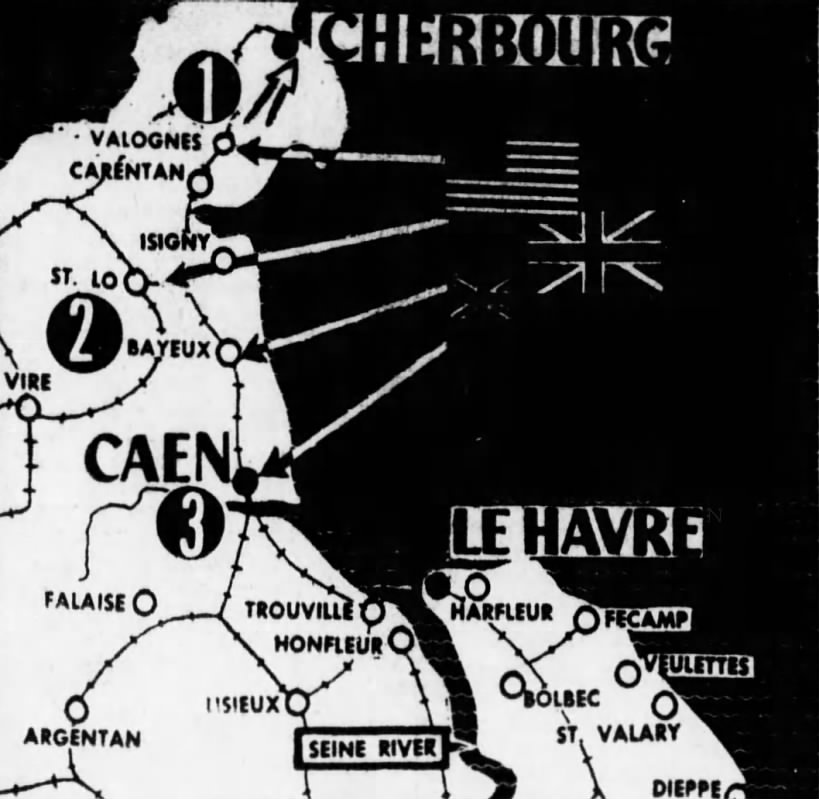Record raids blast Germans in Caen region
7,000 sorties batter massed troops; 1,000 heavies hit airfields
SHAEF, England (UP) –
The greatest air support ever concentrated in a single area, barring perhaps only Cassino, was thrown yesterday against the embattled Caen region by Allied medium and fighter bombers in an attempt to seal off the vast German effort to reinforce its divisions there.
The greater part of about 7,000 sorties flown by Allied bombers and fighters in support of invasion troops in 24 hours ended at midnight was directed against Nazi troop and tank concentrations on the city’s outskirts and on reinforcement columns moving along five main and one auxiliary roads, south and east of Caen.
Allied air forces were moving up for a fight to a finish. It was announced that Americans, British and Canadians were operating at least five emergency landing strips in the beach area. They were being used to refuel patrol fighters and for evacuation of wounded.
While medium and fighter bombers and strafing fighters concentrated on the Caen region, 1,000 U.S. heavy bombers and fighters “backed the attack” of invasion armies with blows against Nazi airdromes.
Simultaneously, bomb-carrying Lightnings of the Italy-based U.S. 15th Air Force attacked Luftwaffe fuel resources in Romania, hammering the “only remaining” oil refinery in the Ploești area, Rome announcements said.
Some 750 Italy-based U.S. heavy bombers also attacked oil installations, railyards and an airdrome near Venice and at Trieste and Bologna, in northern Italy, including one of the largest oil refineries available to the Nazis outside of Romania.
Taking up the air offensive in support of Allied troops after RAF heavy bombers overnight lashed four of the forwardmost Luftwaffe airdromes behind the German lines, up to 500 Flying Fortresses and Liberators swept over airdromes in Normandy and Brittany, including one at Vannes, on the north coast of the Bay of Biscay.
Escorted by some 500 Mustang, Lightning and Thunderbolt fighters which also engaged in supporting sweeps, the big. four-engined U.S. 8th Air Force bombers also answered a call from ground troops and blasted gun positions and defended areas near the north coast of France.
The “North Coast” was not identified, but it was announced the heavy bombers hit gun positions through clouds. Clearer weather was encountered over some inland targets and the airfield at Vannes, believed to be one base from which twin-engined Ju 88s and other coastal raiders launch attacks Allied shipping, was among targets hit visually.
Returning heavy bomber crews reported that “weather was the chief enemy over Normandy.” There were heavy clouds at high altitude. Temperatures were as low as 36 degrees below zero. Escorting fighters gave the bombers such perfect protection that one formation of Me 109s was unable to approach the bomber formations.
1,000 sorties made
The slightly improved weather over the continent also permitted medium and fighter bombers to return to battle after a day’s enforced lull.
In 16 hours from midnight to midafternoon, the Allied air forces had flown 4,000 sorties and dumped 5,000 tons of bombs on troop concentrations, tank columns, communication centers, and airfields.
U.S. 9th Air Force Marauders and Havocs in strength closely supported ground troops in Normandy with attacks on many enemy targets. Their objectives included railyards, track, highways, heavy gun positions and troops, spread out from one to 15 miles behind the fighting lines.
Thunderbolt and Mustang fighter bombers of the U.S. 8th Air Force also attacked German mobile reserves by bombing and strafing from low-level in front of Allied positions. Returning to their bases, they reported little combat with the Luftwaffe. One Mustang group shot down two enemy planes.
While only about 50 German fighters were reported in the battle area, the heaviest weight of Allied attacks was put directly against Nazi troops and supplies moving into the embattled Caen area.
Dozens of enemy road convoys were attacked south and east of the town. One RAF Mustang force destroyed at least 50 vehicles near Fontaine, 12 miles south of Caen, while the U.S. 9th Air Force destroyed many others. Eighth Air Force fighters attacked at least 102 other vehicles.
Block reinforcement
Defying storms during the night, the RAF’s Halifax and Lancaster four-engined bombers attacked Luftwaffe airdromes at Flers, Rennes, Laval and Le Mans to block a reported Luftwaffe attempt to reinforce its assault zone air force, and the rail center of Étampes, 35 miles southwest of Paris, where three important north-south and east-west lines join.
At the same time, Mosquitos of the Bomber Command swept over Berlin to destroy any false confidence Berliners might have had that Allied airpower was tied down by invasion operations. In a concentrated three-minute attack at 1:30 a.m. CET, the speedy Mosquitos hurled more than 30 two-ton bombs on the capital.
It was the first bombing of Berlin since May 27.
Pound communications
RAF light bombers during the night also pounded enemy communications in rear of the battle zone, while night fighters and intruder aircraft shot down four enemy planes which attempted to strike back in some force against the beachheads.
Coastal aircraft throughout the night and day cooperated with naval surface forces in a vigorous offensive against U-boats which Saturday’s noon communiqué said were threatening to attack Allied lines of communications to the assault area.
